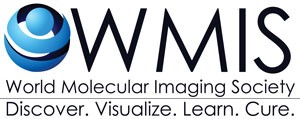Studies Include Non-Invasive Remote HIV Pocket Detection and Specific Pulmonary Infection Detection and Treatment Monitoring
CULVER CITY, Calif. (PRWEB) September 13, 2019 – The World Molecular Imaging Society (WMIS) showcased several first-in-human studies on the detection and treatment of infectious diseases at its annual Congress (WMIC) recently held in Montreal. Highlighting two examples of these ground-breaking studies were noninvasive detection of residual HIV infected cell persistence and the development of pathogen-specific imaging approaches for pulmonary infection. Both studies demonstrate increased biomarker specificity for the disease model and was visualized using Positron Emission Tomography (PET), combined with Magnetic Resonance Imaging (MR) in one project.
The first study, Translation of 89Zr-VRC01 for PET/MR Imaging of Persistence HIV: First-in-Human, was presented by Denis Beckford-Vera, Ph.D., Research Scientist, University of California San Francisco.
“A major obstacle to HIV eradication is the presence of infected cells that persist despite suppressive antiretroviral therapy (ART),” said Dr. Beckford-Vera. “HIV largely resides outside of the peripheral circulation, and thus numerous anatomical and lymphoid tissues that have the capacity to harbor HIV are inaccessible to routine sampling. The purpose of this study was to develop and evaluate a new agent to non-invasively image HIV infection in patients using combined PET/MR.”
Despite the striking success of ART in HIV patients, residual infected cells persist indefinitely. Dr. Beckford-Vera and his team developed a radioconjugate (Zr-89 labeled antibody) that specifically binds to the viral coat protein of HIV which can be detected with PET/MR imaging. The team conducted studies using HIV positive patients and a control non-HIV group. After injecting both groups with the new agent, PET/MR showed greater uptake in places such as lymph node, bowel and bone marrow of the HIV group compared to the control group.
“Overall, we have combined PET/MR imaging with an HIV specific targeted radiotracer to image the HIV reservoir in humans,” said Dr. Beckford-Vera. “This study represents the first imaging study in HIV patients targeting the virus itself. Our research could help to characterize the body-wide burden of HIV, one of the major hurdles to successfully design and implement HIV curative or immune-based therapeutic strategies.”
The Noninvasive Diagnosis and Monitoring of Pulmonary Infections using Pathogen-Specific 18F-Fluorodeoxysorbitol (18F-FDS) PET – First in Human Study was presented by Alvaro Ordonez, M.D., Research Associate, Johns Hopkins University School of Medicine.
Dr. Ordonez indicated imaging tools, such as chest X-ray and computed tomography (CT), are frequently used in the management of pulmonary infections. However, he advised these modalities can be notoriously difficult to interpret as they rely on the presence of nonspecific structural abnormalities that often occur late in the disease process and can mimic other pathologies. Therefore, invasive procedures are frequently needed to diagnose infections.
The team prospectively enrolled patients with microbiologically confirmed pneumonia, due to Enterobacteriaceae, a Gram-negative bacteria such as E. coli, as well as controls with an inflammatory or oncologic pulmonary disease without infection. Patients were injected with 370 MBq of 18F-FDS and PET/CT performed one and two hours post-injection. A follow-up 18F-FDS and PET/CT was also performed in a subset of infected patients after the initiation of antibiotic to monitor the efficacy of the treatments.
The 18F-FDS PET scan was able to specifically detect and localize pulmonary infections in all the Enterobacteriaceae infected patients. PET activity was significantly higher in infected lesions compared with sterile, inflammatory or neoplastic pulmonary lesions demonstrating specificity for infectious lesions. Finally, 18F-FDS PET was also able to monitor the efficacy of antibiotic treatment, demonstrating a decrease in signal intensity and correlating with clinical improvement.
“We presented the first-in-human results of a novel bacteria-class specific PET imaging tracer for rapid and specific detection of pulmonary infections due to Enterobacteriaceae,“ said Dr. Ordonez. “This technology has the potential to substantially improve our ability to detect, monitor and prognosticate deep-seated infections. In addition, it can also help in developing precision medicine approaches for infectious diseases.”
ABOUT WORLD MOLECULAR IMAGING SOCIETY
The WMIS is dedicated to developing and promoting translational research through multimodality molecular imaging. The education and abstract-driven WMIC is the annual meeting of the WMIS and provides a unique setting for scientists and clinicians with very diverse backgrounds to interact, present, and follow cutting-edge advances in the rapidly expanding field of molecular imaging that impacts nearly every biomedical discipline. Industry exhibits at the congress included corporations who have created the latest advances in preclinical and clinical imaging approaches and equipment, providing a complete molecular imaging educational technology showcase. For more information: https://www.wmis.org
###
Read the press release on PRWeb.
Contact: Lisa Baird
Email: lbaird@wmis.org
